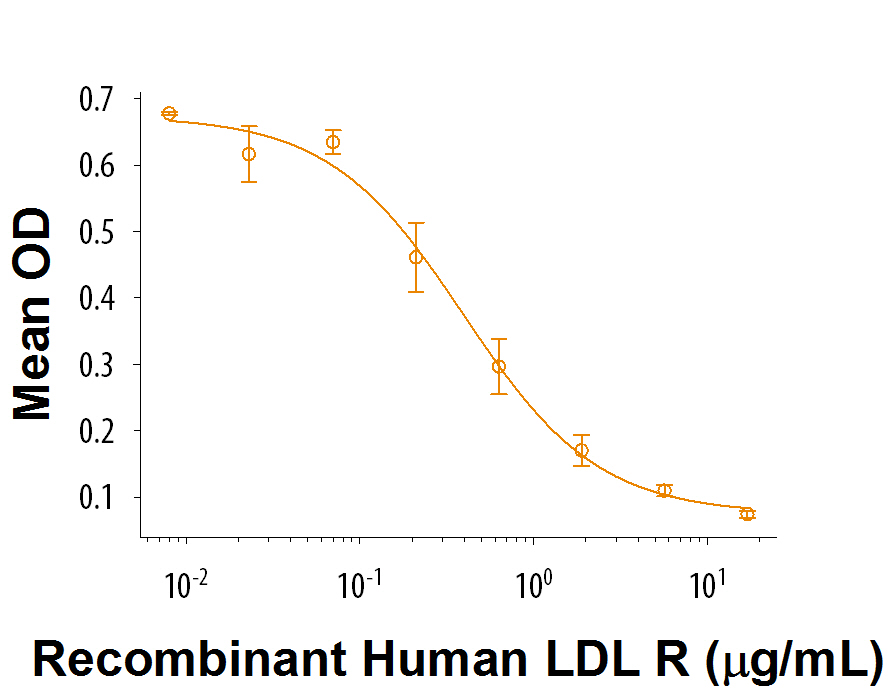Recombinant Human LDLR Protein, CF Summary
Product Specifications
Ala22-Arg788 (Asp193Ala), with a C-terminal 6-His tag
Analysis
Product Datasheets
Carrier Free
CF stands for Carrier Free (CF). We typically add Bovine Serum Albumin (BSA) as a carrier protein to our recombinant proteins. Adding a carrier protein enhances protein stability, increases shelf-life, and allows the recombinant protein to be stored at a more dilute concentration. The carrier free version does not contain BSA.
In general, we advise purchasing the recombinant protein with BSA for use in cell or tissue culture, or as an ELISA standard. In contrast, the carrier free protein is recommended for applications, in which the presence of BSA could interfere.
9177-LD
| Formulation | Lyophilized from a 0.2 μm filtered solution in PBS with Trehalose. |
| Reconstitution | Reconstitute at 100 μg/mL in PBS. |
| Shipping | The product is shipped at ambient temperature. Upon receipt, store it immediately at the temperature recommended below. |
| Stability & Storage: | Use a manual defrost freezer and avoid repeated freeze-thaw cycles.
|
Scientific Data
 View Larger
View Larger
When Human LDL is immobilized at 1 μg/mL (100 μL/well), Recombinant Human LDL R (Catalog # 9177-LD) inhibits the binding between Human LDL and Biotinylated Recombinant Human LDL R. The ED50 for this effect is 0.2-1.2 μg/mL.
Reconstitution Calculator
Background: LDLR
The low density lipoprotein receptor (LDL R) is the founding member of the LDL R family of widely expressed cell surface scavenger receptors (1-5). Members of the family are endocytic receptors, but can also co-regulate adjacent cell-surface signaling molecules (3, 4). Many proteins in the LDL R family are cleaved by extracellular proteases to release soluble forms to the circulation, and many of these soluble forms are active (1, 6). Mature LDL R is a 120-160 kDa (depending on glycosylation) type I transmembrane glycoprotein that contains cysteine-rich complement-like repeats (class A LDL domains), calcium-binding EGF repeats, and
beta -propeller structures (class B LDL repeats) in the extracellular domain (ECD) (1-7). A membrane-proximal Ser/Thr-rich region shows extensive O-linked glycosylation (4, 8). A cytoplasmic NPxY motif links the LDL R to clathrin pits for endocytosis, and binds to select adaptor proteins (1, 4, 8). The human LDL R ECD shares 78%, 76%, 81% and 82% aa sequence identity with mouse, rat, bovine, and porcine LDL R, respectively. LDL R is constitutively and widely expressed. Its class A LDL domains near the N-terminus bind apoB and apoE, the apolipoproteins of low- and very low-density lipoproteins (LDL and VLDL), respectively (1, 2, 4, 9). Hepatocyte LDL R is responsible for endocytosis and clearing of most plasma LDL cholesterol (2, 9). At the low pH of the endocytic vesicle, it dissociates, allowing degradation of LDL and recycling of LDL R to the cell surface (1, 4). Lack of LDL R expression or function causes familial hypercholesterolemia (FH) (4, 9, 10). The protease PCSK9 (proprotein convertase subtilisin/kexin type 9) can also cause increased plasma cholesterol by promoting LDL R degradation rather than recycling to the cell surface (10-12). Soluble forms of approximately 140 kDa and 28 kDa are reported to be released by phorbol esters or interferons, respectively (6, 7).
- Go, G.W. and A. Mani (2012) Yale J. Biol. Med. 85:19.
- Ren, G. et al. (2010) Proc. Natl. Acad. Sci. USA 107:1059.
- Bujo, H. and Y. Saito (2006) Arterioscler. Thromb. Vasc. Biol. 26:1246.
- Gent, J. and I. Braakman (2004) Cell. Mol. Life Sci. 61:2461.
- Yamamoto, T. et al. (1984) Cell 39:27.
- Begg, M.J. et al. (2004) Eur. J. Biochem. 271:524.
- Fischer, D.G. et al. (1993) Science 262:250.
- Stolt, P.C. and H.H. Bock (2006) Cell. Signal. 18:1560.
- Defesche, J.C. (2004) Semin. Vasc. Med. 4:5.
- De Castro-Oros, I. et al. (2010) Appl. Clin Genet. 3:53.
- Zhang, D.W. et al. (2008) Proc. Natl. Acad. Sci. USA 105:13045.
- Tavori, H. et al. (2013) Circulation 127:2403.
FAQs
No product specific FAQs exist for this product, however you may
View all Proteins and Enzyme FAQsReviews for Recombinant Human LDLR Protein, CF
There are currently no reviews for this product. Be the first to review Recombinant Human LDLR Protein, CF and earn rewards!
Have you used Recombinant Human LDLR Protein, CF?
Submit a review and receive an Amazon gift card.
$25/€18/£15/$25CAN/¥75 Yuan/¥2500 Yen for a review with an image
$10/€7/£6/$10 CAD/¥70 Yuan/¥1110 Yen for a review without an image

